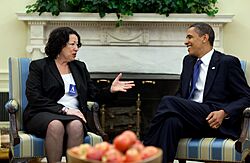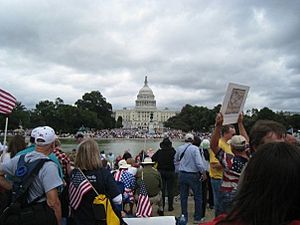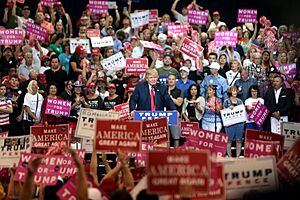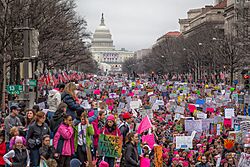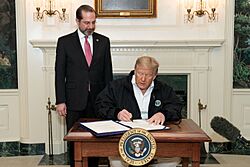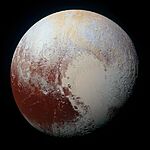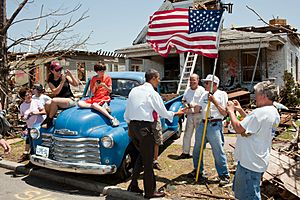History of the United States (2008–present) facts for kids
| 2008–present | |
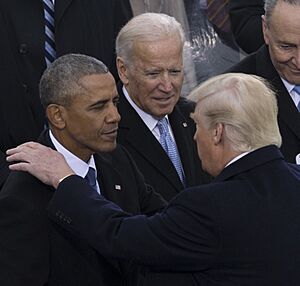
|
|
| Preceded by | History of the United States (1991–2008) |
|---|---|
| Including | War on Terror War on drugs Fourth Industrial Revolution COVID-19 Pandemic Migrations:
|
The history of the United States from 2008 to today started with a big economic problem called the Great Recession. This happened because of a housing bubble that burst. Because of the tough economy, Barack Obama won the presidential election in 2008. He became the first African-American president of the country.
During his time in office, Obama helped the economy with special plans and created the Affordable Care Act to help people get health insurance. In 2011, the Iraq War officially ended. Also, Al-Qaeda leader Osama bin Laden was killed. The War on Terror continued, with more focus on the Islamic State later on.
After Obama, the country saw a very close presidential election in 2016. Businessman Donald Trump won against Hillary Clinton. Trump promised to put "America First" and focused on tax cuts and immigration rules. He also wanted to "Build a Wall" on the US–Mexico border.
In 2020, Joe Biden won the presidential election against Trump. After the election, some of Trump's supporters attacked the United States Capitol on January 6, 2021. Since becoming president, Biden has dealt with the ongoing effects of the COVID-19 pandemic. He also ended the War in Afghanistan and the trade disagreements with China.
Contents
Conflicts and Global Events
War in Afghanistan
The War in Afghanistan continued for many years. In 2008, President Bush sent more troops there. Then, President Barack Obama sent even more troops in 2009 and 2010. This was called a "troop surge." The goal was to fight Taliban groups.
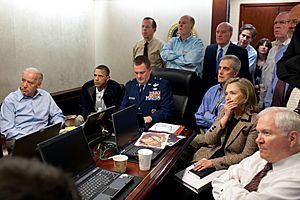
A major event happened on May 1, 2011. President Obama announced that US forces had killed al-Qaeda leader Osama bin Laden in Pakistan. This news was celebrated around the world. However, it also caused some problems in the relationship between the US and Pakistan.
Later, the US began to pull its troops out of Afghanistan. By December 2011, many troops had left. The International Security Assistance Force (ISAF), a group of international troops, stopped fighting in December 2014. Some troops stayed to help train Afghan forces.
Peace talks with the Taliban did not work well. The war continued into the Trump presidency. In February 2020, the US and the Taliban signed a peace deal. This deal planned for US troops to leave Afghanistan by May 1, 2021.
President Joe Biden later changed the withdrawal date to August 31, 2021. As US troops left, the Taliban quickly took control of Afghanistan. The war officially ended on August 15, 2021, when the Taliban took over the capital city, Kabul.
Iraq War
The Iraq War was a difficult conflict. In 2007 and 2008, President Bush sent more troops to Iraq. This helped reduce violence. The main US combat role ended in August 2010. Most US forces left by 2011, and the war was officially over in December 2011.
Politics and Economy
The Great Recession
In 2007, the housing bubble burst, and the United States entered a serious economic downturn called the Great Recession. By mid-2008, property values and other investments dropped sharply. The stock market crashed in October 2008. This led to many job losses and rising unemployment.
The Federal Reserve and the Treasury Department worked together to help the financial system. They provided money to many large financial companies to prevent them from failing. In October 2008, Congress passed a law to protect the US financial system. This law provided up to $700 billion to help troubled financial institutions.
Unemployment nearly doubled to 10% during this time. While the stock market recovered by 2011, unemployment stayed high for a while. This recession affected countries all over the world.
Obama's Time as President
The 2008 election happened when many people were unhappy with the government. Barack Obama, a senator from Illinois, became a strong candidate. He was young and inspiring. The Republican candidate was Senator John McCain.
Obama won the election on November 4, 2008. He became the 44th president and the first African American to hold the office. Democrats also gained more seats in Congress.
Soon after taking office, Obama and Congress passed a $700 billion plan to help the economy recover. This was called the American Recovery and Reinvestment Act of 2009.
A big change during Obama's presidency was the Affordable Care Act. This law aimed to give all Americans access to health insurance. Another important law was the Don't Ask, Don't Tell Repeal Act of 2010. This allowed openly gay people to serve in the military.
In foreign policy, Obama pulled US troops out of Iraq. He also worked with Russia to reduce nuclear weapons. In May 2011, he announced that Osama bin Laden had been killed by US forces.
Even though the economy slowly improved, many voters were still frustrated. A conservative group called the "Tea Party" grew popular. They were against government spending. In the 2010 elections, Republicans gained control of the House of Representatives.
In the 2012 presidential election, Obama won a second term. He defeated Mitt Romney, the Republican candidate.
In November 2014, the Republican Party took control of the Senate and kept their majority in the House.
On December 17, 2014, President Obama announced that the US would restore full diplomatic relations with Cuba. This was the first time since 1961.
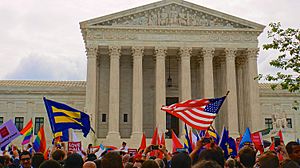
On June 26, 2015, the Supreme Court made a big decision in the case of Obergefell v. Hodges. They ruled that same-sex marriage was a protected right across the country.
Trump's Time as President
In the 2016 presidential election, Donald Trump, a real estate businessman, decided to run. He had a populist message about making America strong again. He quickly gained many supporters. Hillary Clinton won the Democratic nomination.
On November 8, 2016, Trump won the election. He won enough electoral votes, even though he did not win the most individual votes across the country. This was the fifth time in US history that the popular vote and electoral vote results were different. Republicans also kept control of both the House and Senate.
On January 20, 2017, Trump became the 45th US president. He immediately signed executive orders to change policies, including parts of the Affordable Care Act. He also nominated Neil Gorsuch and later Brett Kavanaugh to the Supreme Court.

In December 2017, Congress passed a new tax law called the Tax Cuts and Jobs Act of 2017. This law lowered taxes for businesses and individuals. Many companies then announced pay raises and bonuses for their workers.
Trump also announced plans to leave the Paris Agreement, an international climate agreement. The US officially left the agreement in November 2020.
In December 2019, the House of Representatives voted to impeach President Trump. He was accused of abuse of power. Trump became the third president in US history to be impeached. However, he was later found not guilty by the Senate.
On January 3, 2020, President Trump ordered a drone strike that killed Iranian general Qasem Soleimani. This increased tensions with Iran.
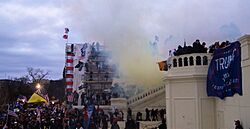
President Trump lost the 2020 presidential election to Joe Biden. On January 6, 2021, supporters of Trump attacked the United States Capitol. Trump was later impeached a second time for his role in the attack, but he was acquitted after leaving office.
Biden's Time as President
Joe Biden became president on January 20, 2021. He is the oldest president to take office at 78 years old. His vice president, Kamala Harris, is the first female vice president in American history.
On his first day, Biden rejoined the Paris Agreement and stopped funding for the border wall. He also focused on fighting the COVID-19 pandemic. He set a goal to give 100 million COVID-19 vaccinations in his first 100 days.
Biden signed a $1.9 trillion plan called the American Rescue Plan Act of 2021 to help the economy during the pandemic. He also signed the Infrastructure Investment and Jobs Act, a plan to improve roads, bridges, and public transport. He appointed Ketanji Brown Jackson to the Supreme Court, making her the first Black woman to serve there.
In foreign policy, Biden completed the withdrawal of US troops from Afghanistan. He shifted US foreign policy to focus more on competition with China and Russia.
In October 2023, Kevin McCarthy was removed as Speaker of the House. This was the first time this had happened in US history. Mike Johnson was elected as the new Speaker later that month.
Both Donald Trump and Joe Biden are planning to run for president again in the 2024 election.
Societal Trends
Religion
A study from 2014 showed that the number of Christians in the United States went down. At the same time, the number of people who do not identify with a religion went up.
Technology
Internet and Related Technologies
More and more people in the US started using the internet. In 2008, about 74% of adults used the internet. By 2021, this number grew to 93%.
New internet services became popular. These included Uber (launched in 2010) for rides and Airbnb (launched in 2008) for booking places to stay. Social media platforms like Instagram (2010) and TikTok (2018) also became very popular. There have been some concerns about TikTok's security.
Other Technological Trends
Fewer people watched traditional television (cable and satellite). More people started watching shows and movies on internet streaming platforms. Also, fewer people used landline phones. More people started using only wireless phones.
Travel and Transportation
Most households in the US have at least one car. The number of people flying on US airlines grew during the 2010s. However, the COVID-19 pandemic caused a big drop in airline passengers in 2020. Travel numbers have been recovering since then.
Space Exploration
Many exciting things happened in space exploration. The Space Shuttle program ended in 2011. The Voyager 1 spacecraft, launched in 1977, became the first spacecraft to enter space between stars in 2012. Voyager 2 did the same in 2018.
NASA's New Horizons probe flew past Pluto in 2015, sending back the first close-up pictures. The Dawn space probe visited the asteroid Vesta in 2011 and the dwarf planet Ceres in 2015. It was the first spacecraft to orbit a dwarf planet. In February 2024, an American craft called IM-1 landed on the Moon. This was the first commercial landing on the Moon ever.
Recreation and Leisure
The number of visitors to National Parks changed over the years. In 2016, a record 330.971 million visits were made. Several new National Parks were created, including White Sands and Indiana Dunes.
More Americans started doing outdoor activities. In 2020, a record 53% of Americans participated in outdoor recreation at least once. Running and jogging were the most popular outdoor activities.
Natural Disasters
The US experienced many natural disasters. In 2011, a series of powerful tornadoes hit the Central and Southern United States. One of the deadliest was the 2011 Joplin tornado in Missouri, which killed 154 people.
In August 2011, Hurricane Irene caused widespread flooding on the East Coast. In October 2012, Hurricane Sandy hit the East Coast, causing huge damage and flooding in places like New York City and New Jersey.
In May 2013, another powerful tornado struck Moore, Oklahoma, causing many deaths and injuries.
In 2017, Hurricane Harvey caused extreme flooding in Houston, Texas. Hurricane Irma hit Florida, and Hurricane Maria devastated Puerto Rico. These hurricanes caused billions of dollars in damage.
In 2018, Hurricane Florence caused major flooding in North Carolina, and Hurricane Michael hit Florida as a very strong storm. Later that year, several wildfires caused massive destruction in California, including the deadliest wildfire in California history, the Camp Fire.
In July 2019, a series of earthquakes hit Southern California. The largest was a 7.1 magnitude earthquake. In August 2023, wildfires in Hawaii, especially on the island of Maui, caused significant damage and loss of life.
See also
- Presidency of George W. Bush
- Presidency of Barack Obama
- Presidency of Donald Trump
- Presidency of Joe Biden
- Outline of United States history
- Timeline of the history of the United States (1990–2009)
- Timeline of the history of the United States (2010–present)
- Timeline of modern American conservatism
- List of federal political scandals in the United States
Images for kids



